2016 NISSAN SENTRA maintenance
[x] Cancel search: maintenancePage 438 of 478
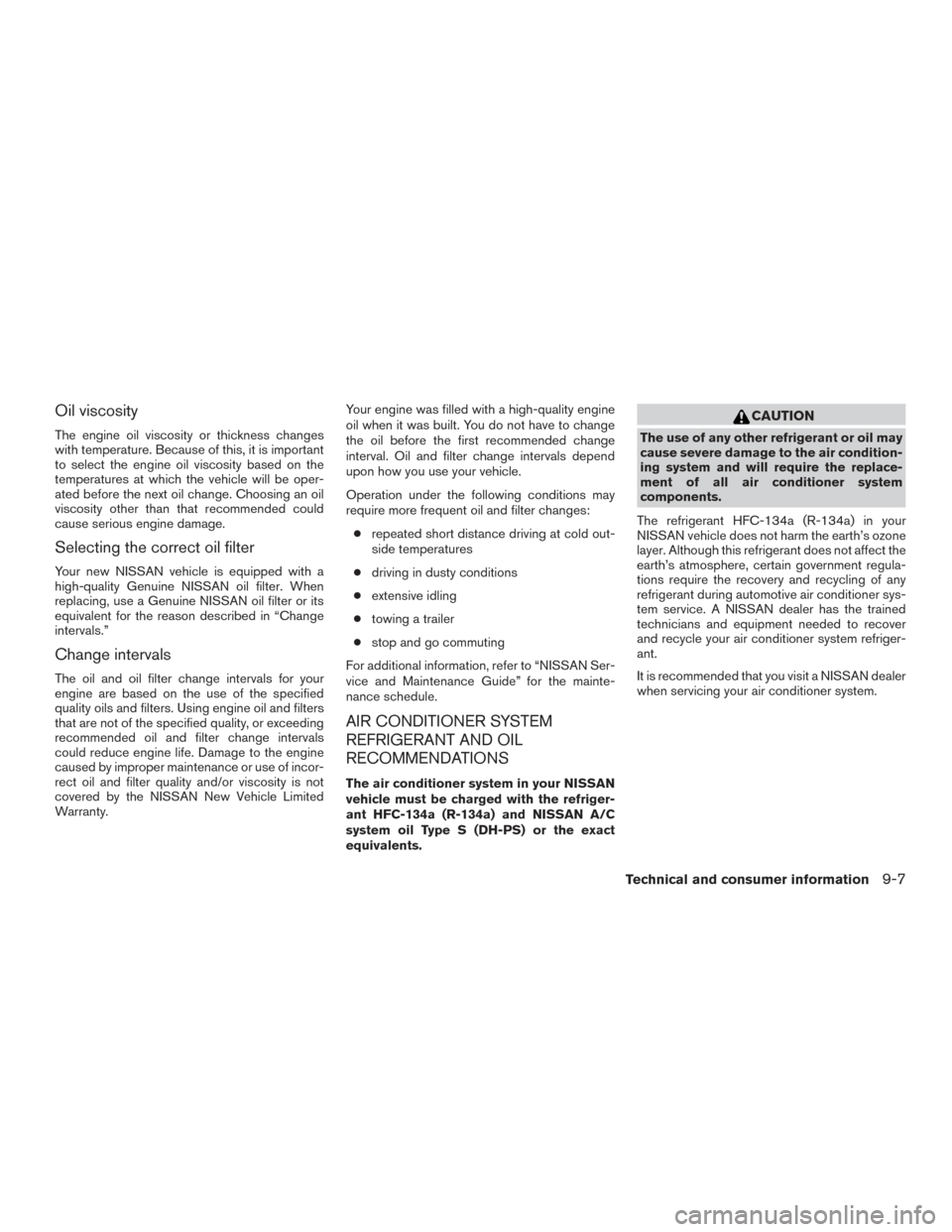
Oil viscosity
The engine oil viscosity or thickness changes
with temperature. Because of this, it is important
to select the engine oil viscosity based on the
temperatures at which the vehicle will be oper-
ated before the next oil change. Choosing an oil
viscosity other than that recommended could
cause serious engine damage.
Selecting the correct oil filter
Your new NISSAN vehicle is equipped with a
high-quality Genuine NISSAN oil filter. When
replacing, use a Genuine NISSAN oil filter or its
equivalent for the reason described in “Change
intervals.”
Change intervals
The oil and oil filter change intervals for your
engine are based on the use of the specified
quality oils and filters. Using engine oil and filters
that are not of the specified quality, or exceeding
recommended oil and filter change intervals
could reduce engine life. Damage to the engine
caused by improper maintenance or use of incor-
rect oil and filter quality and/or viscosity is not
covered by the NISSAN New Vehicle Limited
Warranty.Your engine was filled with a high-quality engine
oil when it was built. You do not have to change
the oil before the first recommended change
interval. Oil and filter change intervals depend
upon how you use your vehicle.
Operation under the following conditions may
require more frequent oil and filter changes:
● repeated short distance driving at cold out-
side temperatures
● driving in dusty conditions
● extensive idling
● towing a trailer
● stop and go commuting
For additional information, refer to “NISSAN Ser-
vice and Maintenance Guide” for the mainte-
nance schedule.
AIR CONDITIONER SYSTEM
REFRIGERANT AND OIL
RECOMMENDATIONS
The air conditioner system in your NISSAN
vehicle must be charged with the refriger-
ant HFC-134a (R-134a) and NISSAN A/C
system oil Type S (DH-PS) or the exact
equivalents.
CAUTION
The use of any other refrigerant or oil may
cause severe damage to the air condition-
ing system and will require the replace-
ment of all air conditioner system
components.
The refrigerant HFC-134a (R-134a) in your
NISSAN vehicle does not harm the earth’s ozone
layer. Although this refrigerant does not affect the
earth’s atmosphere, certain government regula-
tions require the recovery and recycling of any
refrigerant during automotive air conditioner sys-
tem service. A NISSAN dealer has the trained
technicians and equipment needed to recover
and recycle your air conditioner system refriger-
ant.
It is recommended that you visit a NISSAN dealer
when servicing your air conditioner system.
Technical and consumer information9-7
Page 452 of 478
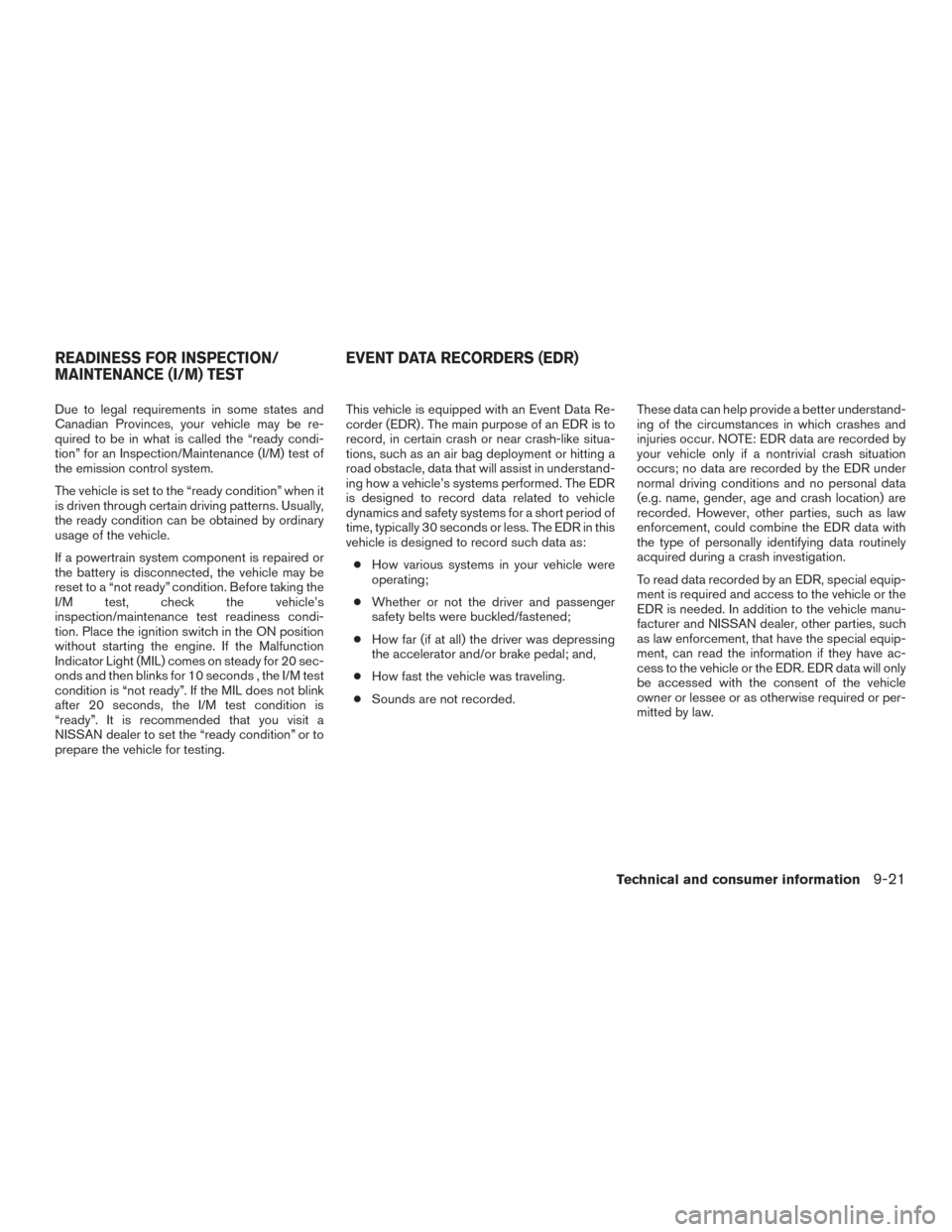
Due to legal requirements in some states and
Canadian Provinces, your vehicle may be re-
quired to be in what is called the “ready condi-
tion” for an Inspection/Maintenance (I/M) test of
the emission control system.
The vehicle is set to the “ready condition” when it
is driven through certain driving patterns. Usually,
the ready condition can be obtained by ordinary
usage of the vehicle.
If a powertrain system component is repaired or
the battery is disconnected, the vehicle may be
reset to a “not ready” condition. Before taking the
I/M test, check the vehicle’s
inspection/maintenance test readiness condi-
tion. Place the ignition switch in the ON position
without starting the engine. If the Malfunction
Indicator Light (MIL) comes on steady for 20 sec-
onds and then blinks for 10 seconds , the I/M test
condition is “not ready”. If the MIL does not blink
after 20 seconds, the I/M test condition is
“ready”. It is recommended that you visit a
NISSAN dealer to set the “ready condition” or to
prepare the vehicle for testing.This vehicle is equipped with an Event Data Re-
corder (EDR) . The main purpose of an EDR is to
record, in certain crash or near crash-like situa-
tions, such as an air bag deployment or hitting a
road obstacle, data that will assist in understand-
ing how a vehicle’s systems performed. The EDR
is designed to record data related to vehicle
dynamics and safety systems for a short period of
time, typically 30 seconds or less. The EDR in this
vehicle is designed to record such data as:
● How various systems in your vehicle were
operating;
● Whether or not the driver and passenger
safety belts were buckled/fastened;
● How far (if at all) the driver was depressing
the accelerator and/or brake pedal; and,
● How fast the vehicle was traveling.
● Sounds are not recorded. These data can help provide a better understand-
ing of the circumstances in which crashes and
injuries occur. NOTE: EDR data are recorded by
your vehicle only if a nontrivial crash situation
occurs; no data are recorded by the EDR under
normal driving conditions and no personal data
(e.g. name, gender, age and crash location) are
recorded. However, other parties, such as law
enforcement, could combine the EDR data with
the type of personally identifying data routinely
acquired during a crash investigation.
To read data recorded by an EDR, special equip-
ment is required and access to the vehicle or the
EDR is needed. In addition to the vehicle manu-
facturer and NISSAN dealer, other parties, such
as law enforcement, that have the special equip-
ment, can read the information if they have ac-
cess to the vehicle or the EDR. EDR data will only
be accessed with the consent of the vehicle
owner or lessee or as otherwise required or per-
mitted by law.
READINESS FOR INSPECTION/
MAINTENANCE (I/M) TEST
EVENT DATA RECORDERS (EDR)
Technical and consumer information9-21
Page 456 of 478
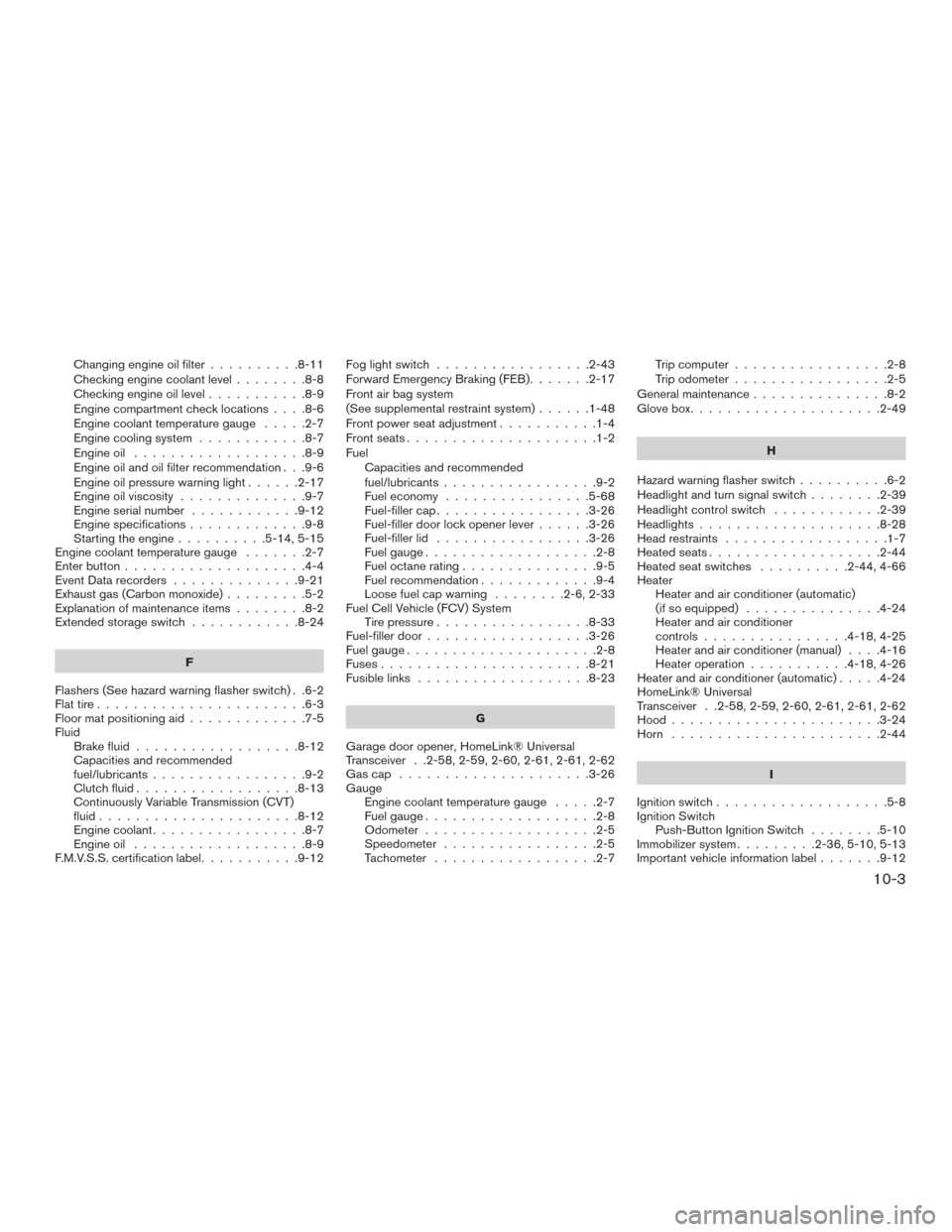
Changing engine oil filter..........8-11
Checking engine coolant level ........8-8
Checking engine oil level ...........8-9
Engine compartment check locations ....8-6
Engine coolant temperature gauge .....2-7
Engine cooling system ............8-7
Engine oil ...................8-9
Engine oil and oil filter recommendation . . .9-6
Engine oil pressure warning light ......2-17
Engine oil viscosity ..............9-7
Engine serial number ............9-12
Engine specifications .............9-8
Starting the engine ..........5-14,5-15
Engine coolant temperature gauge .......2-7
Enterbutton....................4-4
Event Data recorders ..............9-21
Exhaust gas (Carbon monoxide) .........5-2
Explanation of maintenance items ........8-2
Extendedstorageswitch ............8-24
F
Flashers (See hazard warning flasher switch) . .6-2
Flat tire .......................6-3
Floor mat positioning aid .............7-5
Fluid Brake fluid ..................8-12
Capacities and recommended
fuel/lubricants .................9-2
Clutchfluid..................8-13
Continuously Variable Transmission (CVT)
fluid......................8-12
Engine coolant .................8-7
Engine oil ...................8-9
F.M.V.S.S. certification label ...........9-12Foglightswitch .................2-43
Forward Emergency Braking (FEB)
.......2-17
Front air bag system
(See supplemental restraint system) ......1-48
Front power seat adjustment ...........1-4
Frontseats.....................1-2
Fuel Capacities and recommended
fuel/lubricants .................9-2
Fuel economy ................5-68
Fuel-filler cap .................3-26
Fuel-filler door lock opener lever ......3-26
Fuel-filler lid .................3-26
Fuel gauge ...................2-8
Fuel octane rating ...............9-5
Fuel recommendation .............9-4
Loose fuel cap warning ........2-6,2-33
Fuel Cell Vehicle (FCV) System Tirepressure.................8-33
Fuel-filler door ..................3-26
Fuelgauge.....................2-8
Fuses.......................8-21
Fusiblelinks ...................8-23
G
Garage door opener, HomeLink® Universal
Transceiver . .2-58, 2-59, 2-60, 2-61, 2-61, 2-62
Gascap .....................3-26
Gauge Engine coolant temperature gauge .....2-7
Fuel gauge ...................2-8
Odometer ...................2-5
Speedometer .................2-5
Tachometer ..................2-7 Trip computer
.................2-8
Trip odometer .................2-5
General maintenance ...............8-2
Glovebox.....................2-49
H
Hazard
warning flasher switch ..........6-2
Headlightandturnsignalswitch........2-39
Headlightcontrolswitch ............2-39
Headlights....................8-28
Head restraints ..................1-7
Heated seats ...................2-44
Heated seat switches ..........2-44,4-66
Heater Heater and air conditioner (automatic)
(if so equipped) ...............4-24
Heater and air conditioner
controls ................4-18,4-25
Heater and air conditioner (manual) ....4-16
Heater operation ...........4-18,4-26
Heater and air conditioner (automatic) .....4-24
HomeLink® Universal
Transceiver . .2-58, 2-59, 2-60, 2-61, 2-61, 2-62
Hood.......................3-24
Horn .......................2-44
I
Ignition switch ...................5-8
Ignition Switch Push-Button Ignition Switch ........5-10
Immobilizer system .........2-36,5-10,5-13
Important vehicle information label .......9-12
10-3
Page 457 of 478

In-cabin microfilter................8-18
Increasing fuel economy .............5-68
Indicator lights and audible reminders
(See warning/indicator lights and audible
reminders)..........2-15,2-16,2-21,3-20
Informationdisplay................2-24
Inside automatic anti-glare mirror ........3-31
Instrument brightness control ..........2-42
Instrument panel ...............0-6,2-2
Instrument panel dimmer switch ........2-42
Intelligent cruise control (ICC) system Brake assist .................5-45
Intelligent Key system Key operating range .............3-12
Key operation ................3-13
Mechanicalkey ................3-4
Remote keyless entry operation ....3-8,3-16
Troubleshooting guide ............3-22
Warning signals ...............3-22
Interiorlight................2-56,2-57
Interiortrunklidrelease.............3-25
iPod®Player ...............4-55,4-57
ISOFIX child restraints .............1-23
J
Jump starting ................6-8,8-15
K
Key.........................3-2
Key fob battery replacement .......8-25,8-25Keyless entry
With Intelligent Key system
(See Intelligent Key system) ......3-8,3-16
Without Intelligent Key system
(See remote keyless entry system) ......3-7
Keys NISSAN Intelligent Key® .......3-2,3-10
NISSAN Vehicle Immobilizer System keys . .3-4
L
Labels Air conditioner specification label .....9-13
C.M.V.S.S. certification label ........9-12
Emission control information label .....9-12
Engine serial number ............9-12
F.M.V.S.S. certification label .........9-12
Tire and Loading Information label .....9-13
Vehicle identification number (VIN) .....9-11
Vehicle identification number (VIN) plate . .9-11
Warning labels (for SRS) ..........1-58
LATCH (Lower Anchors and Tethers for CHildren)
System ......................1-23
License plate Installing the license plate ..........9-13
Light Air bag warning light .........1-59,2-20
Brake light (See stop light) .........8-31
Bulb check/instrument panel ........2-16
Bulbreplacement..............8-31
Charge warning light ............2-17
Consolelight.................2-57
Exterior and Interior lights ..........8-31
Foglights...................8-29
Foglightswitch ...............2-43 Headlightandturnsignalswitch......2-39
Headlight control switch
..........2-39
Headlights..................8-28
Interiorlight..............2-56,2-57
Lightbulbs..................8-28
Low tire pressure warning light .......2-18
Low windshield-washer fluid warning
light ..................2-19,2-33
Passenger air bag and status light .....1-50
Security indicator light ............2-22
Spotlights(Seemaplight) .........2-58
Trunklight ..................2-58
Warning/indicator lights and audible
reminders ........2-15,2-16,2-21,3-20
Lights.......................8-28 Maplights ..................2-58
Lock Child safety rear door lock ..........3-6
Fuel-filler door lock opener lever ......3-26
Power door locks ............3-5,3-6
Trunk lid lock opener lever ..........3-25
Loose
fuel cap warning ..........2-6,2-33
Low fuel warning light .......2-17,2-19,2-33
Low tire pressure warning light .........2-18
Low windshield-washer fluid warning
light ....................2-19,2-33
Luggage (See vehicle loading information) . .9-14
M
Maintenance General maintenance .............8-2
Insidethevehicle...............8-3
Maintenance precautions ...........8-5
Outside the vehicle ..............8-2
10-4
Page 458 of 478
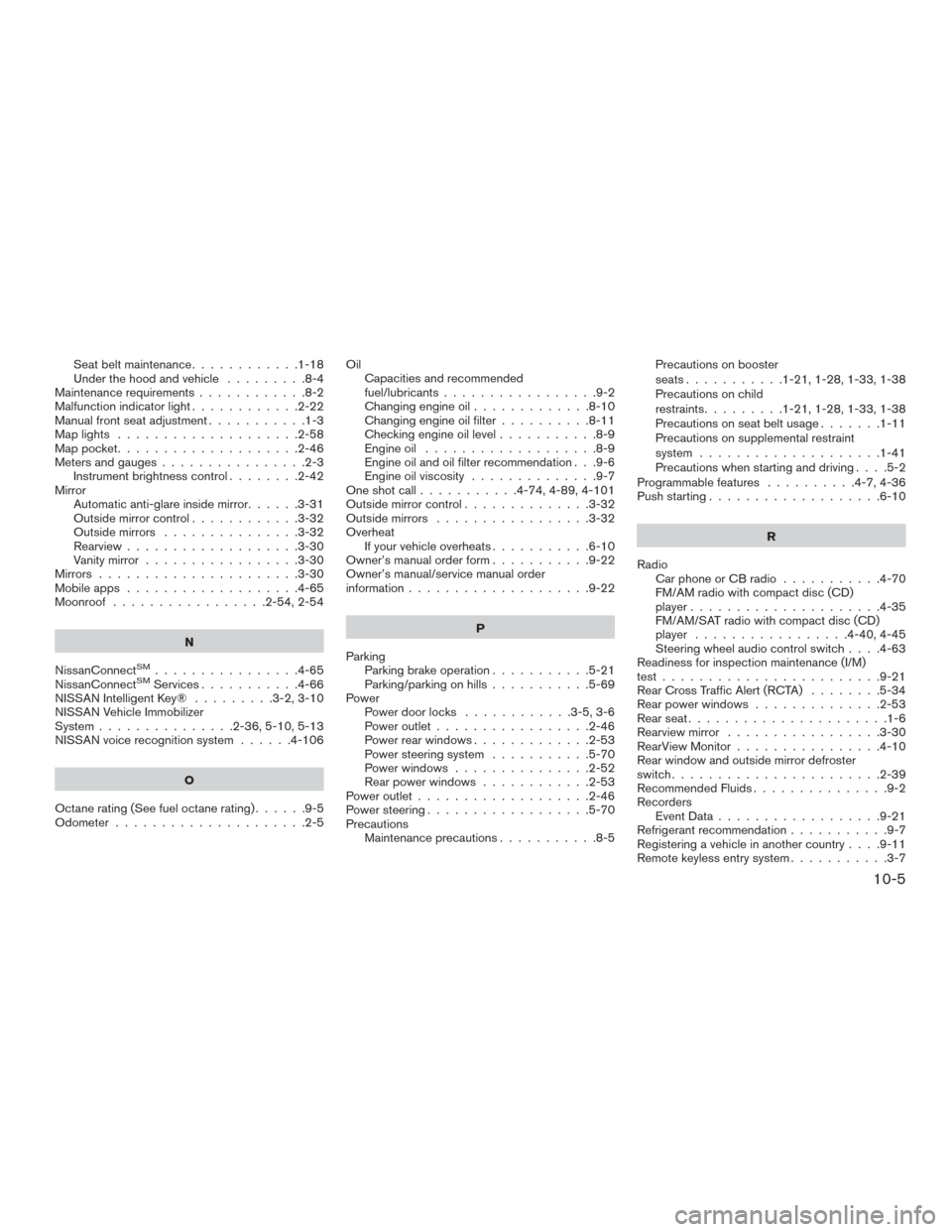
Seat belt maintenance............1-18
Under the hood and vehicle .........8-4
Maintenance requirements ............8-2
Malfunction indicator light ............2-22
Manual front seat adjustment ...........1-3
Maplights ....................2-58
Map pocket ....................2-46
Meters and gauges ................2-3
Instrument brightness control ........2-42
Mirror Automatic anti-glare inside mirror ......3-31
Outside mirror control ............3-32
Outside mirrors ...............3-32
Rearview ...................3-30
Vanity mirror .................3-30
Mirrors ......................3-30
Mobileapps ...................4-65
Moonroof .................2-54,2-54
N
NissanConnect
SM................4-65
NissanConnectSMServices...........4-66
NISSAN Intelligent Key® .........3-2,3-10
NISSAN Vehicle Immobilizer
System ...............2-36,5-10,5-13
NISSAN voice recognition system ......4-106
O
Octanerating(Seefueloctanerating)......9-5
Odometer .....................2-5 Oil
Capacities and recommended
fuel/lubricants .................9-2
Changingengineoil.............8-10
Changing engine oil filter ..........8-11
Checking engine oil level ...........8-9
Engine oil ...................8-9
Engine oil and oil filter recommendation . . .9-6
Engine oil viscosity ..............9-7
Oneshotcall...........4-74,4-89,4-101
Outside mirror control ..............3-32
Outside mirrors .................3-32
Overheat If your vehicle overheats ...........6-10
Owner’s manual order form ...........9-22
Owner’s manual/service manual order
information ....................9-22
P
Parking Parking brake operation ...........5-21
Parking/parking on hills ...........5-69
Power Power door locks ............3-5,3-6
Power outlet .................2-46
Power rear windows .............2-53
Power steering system ...........5-70
Power windows ...............2-52
Rear power windows ............2-53
Power outlet ...................2-46
Power steering ..................5-70
Precautions Maintenance precautions ...........8-5 Precautions on booster
seats
...........1-21,1-28,1-33,1-38
Precautions on child
restraints .........1-21,1-28,1-33,1-38
Precautions on seat belt usage .......1-11
Precautions on supplemental restraint
system ....................1-41
Precautions when starting and driving ....5-2
Programmable features ..........4-7,4-36
Push starting ...................6-10
R
Radio CarphoneorCBradio ...........4-70
FM/AM radio with compact disc (CD)
player .....................4-35
FM/AM/SAT radio with compact disc (CD)
player .................4-40,4-45
Steering wheel audio control switch . . . .4-63
Readiness for inspection maintenance (I/M)
test ........................9-21
Rear Cross Traffic Alert (RCTA) ........5-34
Rear power windows ..............2-53
Rearseat......................1-6
Rearview mirror .................3-30
RearView Monitor ................4-10
Rear window and outside mirror defroster
switch.......................2-39
Recommended Fluids ...............9-2
Recorders EventData..................9-21
Refrigerant recommendation ...........
9-7
Registering a vehicle in another country ....9-11
Remote keyless entry system ...........3-7
10-5
Page 459 of 478
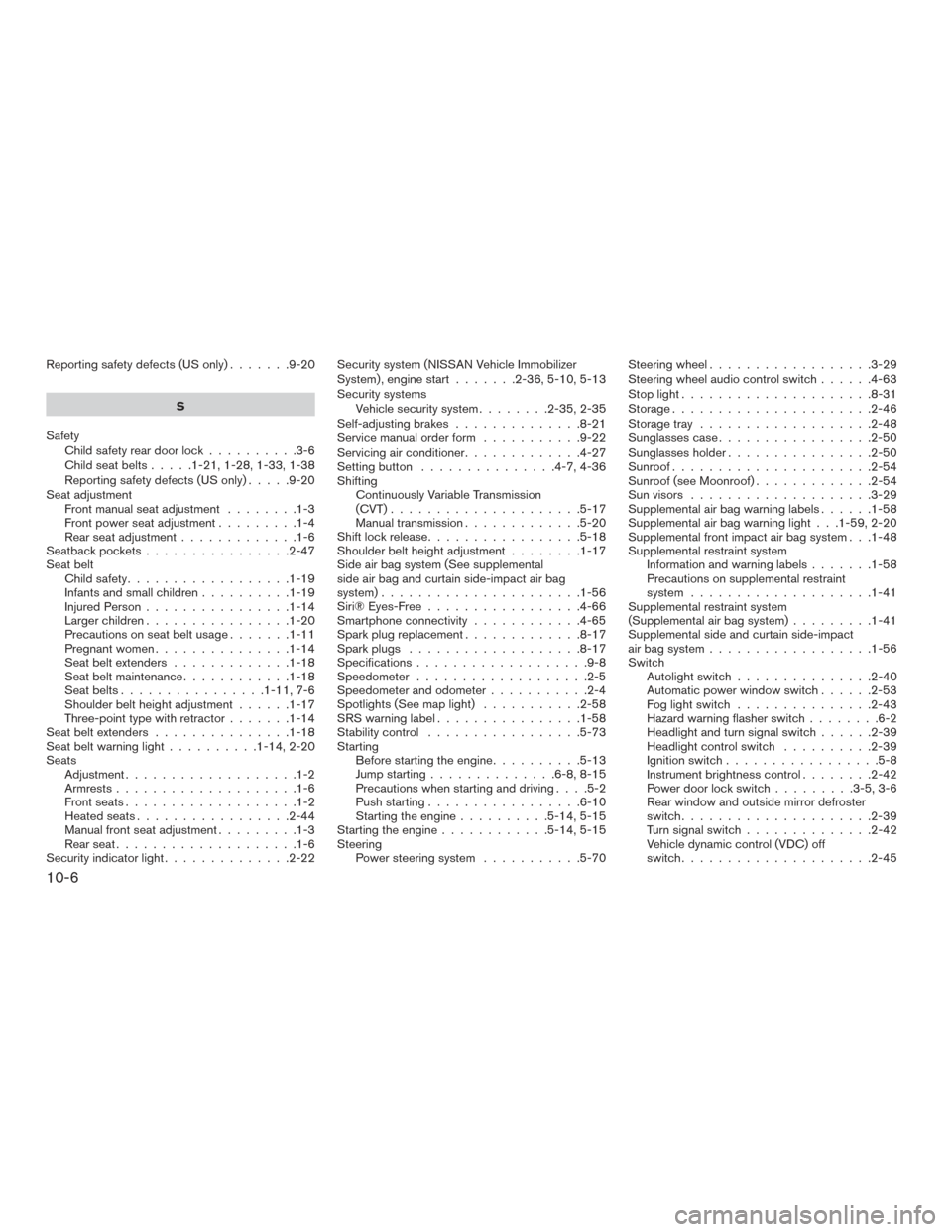
Reporting safety defects (US only).......9-20
S
Safety Child safety rear door lock ..........3-6
Childseatbelts.....1-21,1-28,1-33,1-38
Reporting safety defects (US only) .....9-20
Seat adjustment Front manual seat adjustment ........1-3
Front power seat adjustment .........1-4
Rear seat adjustment .............1-6
Seatback pockets ................2-47
Seat belt Childsafety..................1-19
Infantsandsmallchildren..........1-19
Injured Person ................1-14
Largerchildren................1-20
Precautionsonseatbeltusage.......1-11
Pregnant women ...............1-14
Seat belt extenders .............1-18
Seat belt maintenance ............1-18
Seat belts ................1-11,7-6
Shoulder belt height adjustment ......1-17
Three-point type with retractor .......1-14
Seat belt extenders ...............1-18
Seatbeltwarninglight..........1-14,2-20
Seats Adjustment ...................1-2
Armrests....................1-6
Frontseats...................1-2
Heatedseats.................2-44
Manual front seat adjustment .........1-3
Rear seat ....................1-6
Security indicator light ..............2-22 Security system (NISSAN Vehicle Immobilizer
System) , engine start
.......2-36,5-10,5-13
Security systems Vehicle security system ........2-35,2-35
Self-adjusting brakes ..............8-21
Service manual order form ...........9-22
Servicing air conditioner .............4-27
Setting button ...............4-7,4-36
Shifting Continuously Variable Transmission
(CVT) .....................5-17
Manual transmission .............5-20
Shiftlockrelease.................5-18
Shoulder belt height adjustment ........1-17
Side air bag system (See supplemental
side air bag and curtain side-impact air bag
system) ......................1-56
Siri® Eyes-Free .................4-66
Smartphone connectivity ............4-65
Sparkplugreplacement.............8-17
Sparkplugs ...................8-17
Specifications ...................9-8
Speedometer ...................2-5
Speedometer and odometer ...........2-4
Spotlights(Seemaplight) ...........2-58
SRSwarninglabel................1-58
Stability control .................5-73
Starting Before starting the engine ..........5-13
Jump starting ..............6-8,8-15
Precautions when starting and driving ....5-2
Push starting .................6-10
Starting the engine ..........5-14,5-15
Starting the engine ............5-14,5-15
Steering Power steering system ...........5-70 Steering wheel
..................3-29
Steering wheel audio control switch ......4-63
Stoplight.....................8-31
Storage......................2-46
Storage tray ...................2-48
Sunglasses case .................2-50
Sunglasses
holder ................2-50
Sunroof......................2-54
Sunroof(seeMoonroof).............2-54
Sun visors ....................3-29
Supplemental air bag warning labels ......1-58
Supplemental air bag warning light . . .1-59, 2-20
Supplemental front impact air bag system . . .1-48
Supplemental restraint system Information and warning labels .......1-58
Precautions on supplemental restraint
system ....................1-41
Supplemental restraint system
(Supplemental air bag system) .........1-41
Supplemental side and curtain side-impact
airbagsystem..................1-56
Switch Autolightswitch...............2-40
Automatic power window switch ......2-53
Fog light switch ...............2-43
Hazard warning flasher switch ........6-2
Headlightandturnsignalswitch......2-39
Headlight control switch ..........2-39
Ignition switch .................5-8
Instrument brightness control ........2-42
Power door lock switch .........3-5,3-6
Rear window and outside mirror defroster
switch .....................2-39
Turnsignalswitch..............2-42
Vehicle dynamic control (VDC) off
switch .....................2-45
10-6
Page 462 of 478
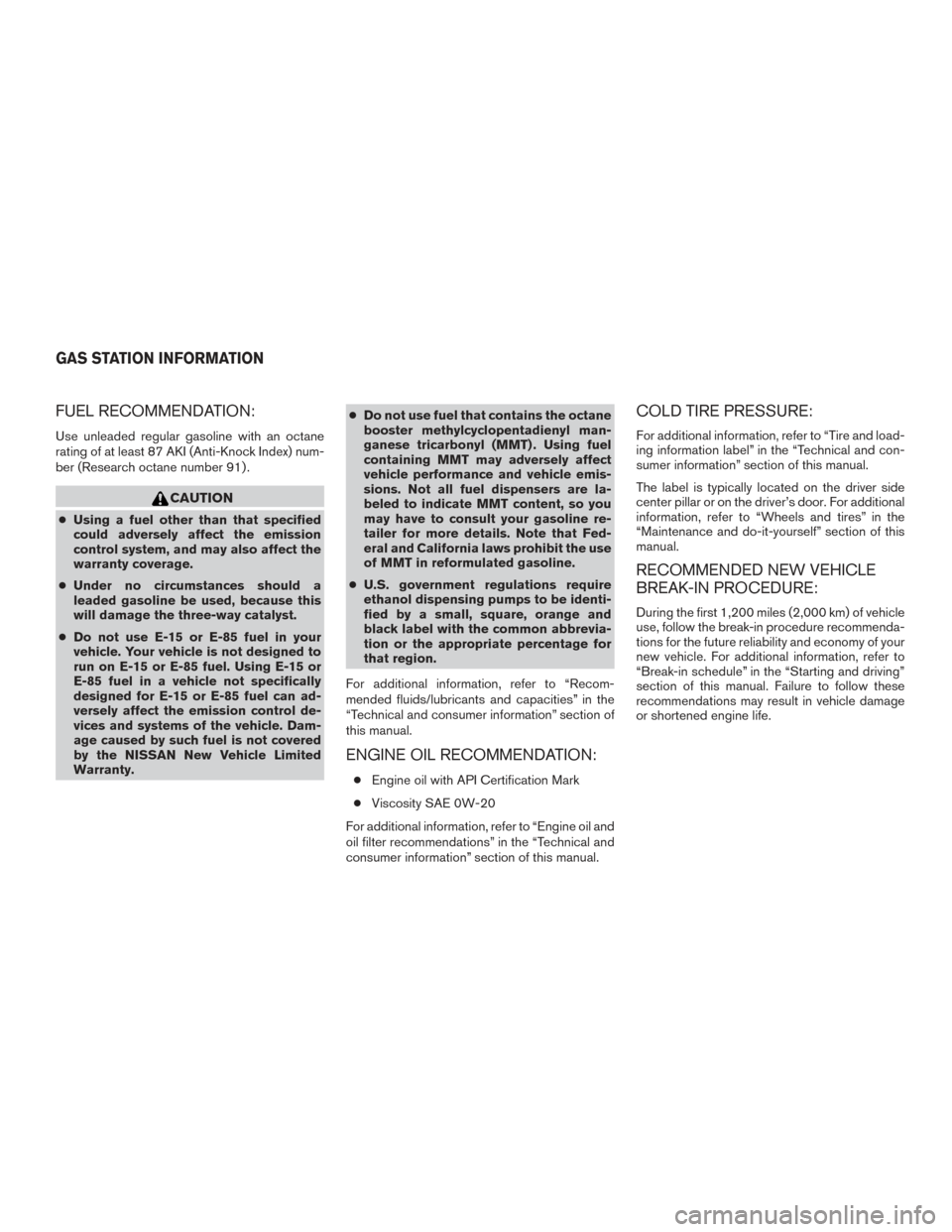
FUEL RECOMMENDATION:
Use unleaded regular gasoline with an octane
rating of at least 87 AKI (Anti-Knock Index) num-
ber (Research octane number 91) .
CAUTION
●Using a fuel other than that specified
could adversely affect the emission
control system, and may also affect the
warranty coverage.
● Under no circumstances should a
leaded gasoline be used, because this
will damage the three-way catalyst.
● Do not use E-15 or E-85 fuel in your
vehicle. Your vehicle is not designed to
run on E-15 or E-85 fuel. Using E-15 or
E-85 fuel in a vehicle not specifically
designed for E-15 or E-85 fuel can ad-
versely affect the emission control de-
vices and systems of the vehicle. Dam-
age caused by such fuel is not covered
by the NISSAN New Vehicle Limited
Warranty. ●
Do not use fuel that contains the octane
booster methylcyclopentadienyl man-
ganese tricarbonyl (MMT) . Using fuel
containing MMT may adversely affect
vehicle performance and vehicle emis-
sions. Not all fuel dispensers are la-
beled to indicate MMT content, so you
may have to consult your gasoline re-
tailer for more details. Note that Fed-
eral and California laws prohibit the use
of MMT in reformulated gasoline.
● U.S. government regulations require
ethanol dispensing pumps to be identi-
fied by a small, square, orange and
black label with the common abbrevia-
tion or the appropriate percentage for
that region.
For additional information, refer to “Recom-
mended fluids/lubricants and capacities” in the
“Technical and consumer information” section of
this manual.
ENGINE OIL RECOMMENDATION:
● Engine oil with API Certification Mark
● Viscosity SAE 0W-20
For additional information, refer to “Engine oil and
oil filter recommendations” in the “Technical and
consumer information” section of this manual.
COLD TIRE PRESSURE:
For additional information, refer to “Tire and load-
ing information label” in the “Technical and con-
sumer information” section of this manual.
The label is typically located on the driver side
center pillar or on the driver’s door. For additional
information, refer to “Wheels and tires” in the
“Maintenance and do-it-yourself” section of this
manual.
RECOMMENDED NEW VEHICLE
BREAK-IN PROCEDURE:
During the first 1,200 miles (2,000 km) of vehicle
use, follow the break-in procedure recommenda-
tions for the future reliability and economy of your
new vehicle. For additional information, refer to
“Break-in schedule” in the “Starting and driving”
section of this manual. Failure to follow these
recommendations may result in vehicle damage
or shortened engine life.
GAS STATION INFORMATION